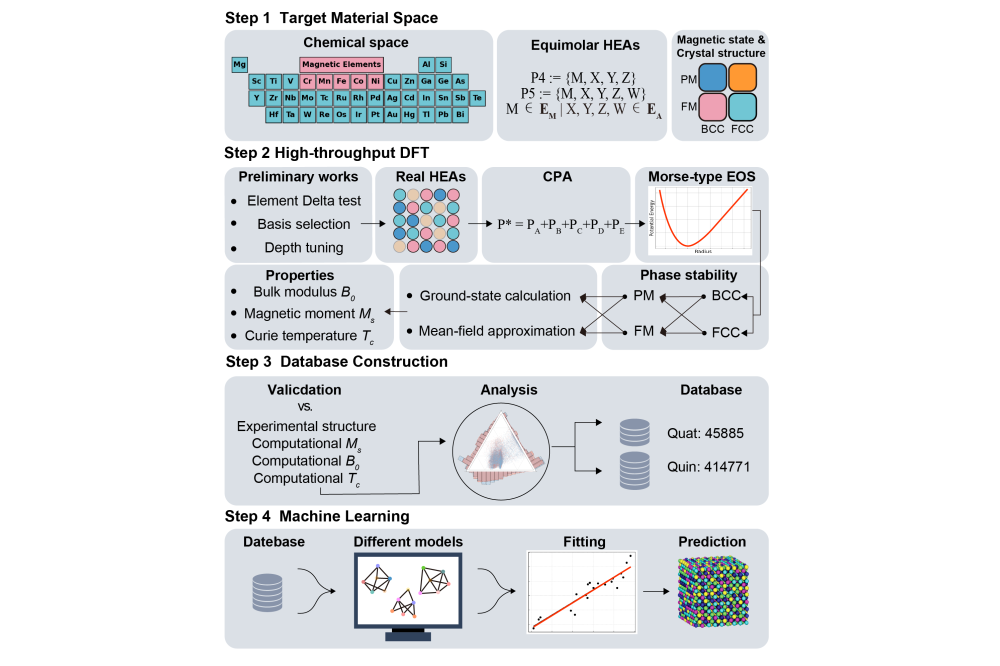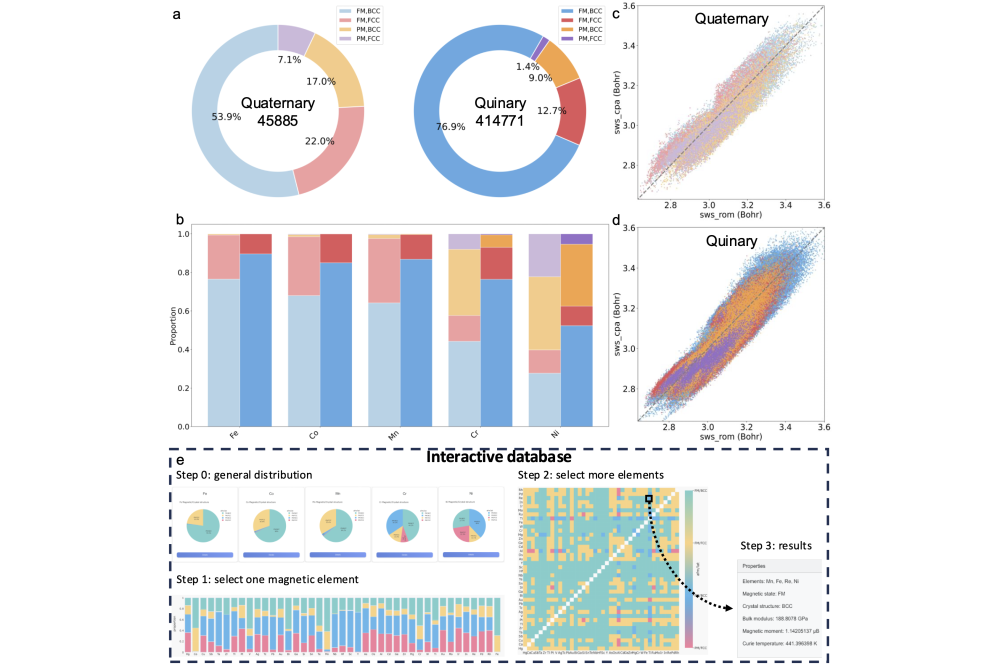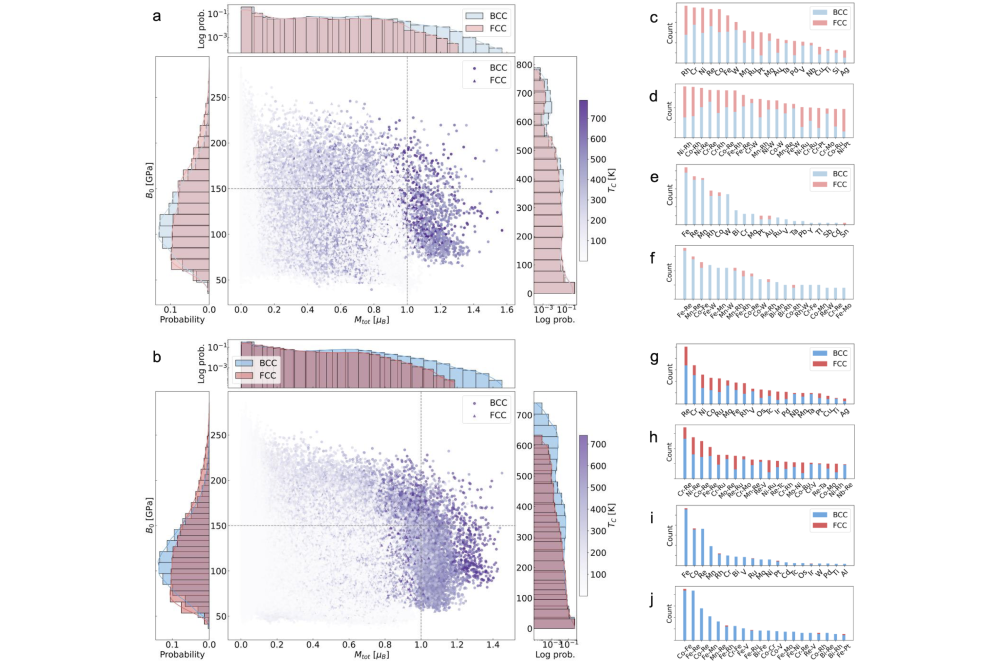High-Throughput Design of High Entropy Alloys
Introduction
The quest for advanced materials that simultaneously exhibit high mechanical hardness and soft magnetic behavior poses a significant challenge in materials science. Such multifunctional properties are essential for next-generation technologies in energy, electronics, and transportation. Exploring the vast compositional landscape of high-entropy alloys (HEAs), which offer immense chemical design flexibility, requires computational strategies that go beyond traditional trial-and-error approaches. In this work, we leverage high-performance computing (HPC) to conduct over 1.8 million density functional theory (DFT) calculations across quaternary and quinary equimolar HEAs constructed from 42 elements.
Methods
We employed a high-throughput density functional theory (HTP-DFT) workflow to evaluate the structural, mechanical, and magnetic properties of equimolar HEAs. All calculations used the generalized gradient approximation (GGA) in the Perdew-Burke- Ernzerhof (PBE) form [1] to describe exchange-correlation effects. The electronic structure was solved using the exact muffin-tin orbital (EMTO) method [2, 3], combined with the coherent potential approximation (CPA) [4] to treat chemical disorder. Scalar-relativistic effects and a soft-core basis set were included, and total energies were computed using the full charge density technique [5] within an optimized overlapping muffin-tin potential framework.
A dense 17 × 17 × 17 k-point mesh ensured Brillouin zone sampling convergence. Calculations were performed across at least eleven volumes for body-centered cubic (BCC) and face-centered cubic (FCC) structures, and bulk moduli were obtained by fitting the energy-volume data to a Morse-type equation of state [6]. Magnetic properties were evaluated in both ferromagnetic (FM) and paramagnetic (PM) states. The PM state was modeled using the disordered local moment (DLM) approximation, and the Curie temperature TC was estimated using a mean-field approximation (MFA) [7].
Results
1. Interactive database for high-entropy magnets
We developed a comprehensive HEA database comprising 45,885 quaternary and 414,771 quinary equimolar compositions, with an interactive interface to support systematic exploration. High-throughput EMTO-CPA calculations revealed that ferromagnetic BCC phases dominate, especially in quinary systems. Validation against literature confirms high phase classification accuracy, with minor deviations explained by small energy differences and the need for finite-temperature considerations. Element-wise analysis shows that Fe, Co, and Mn favor FM-BCC structures, while Cr and Ni exhibit more diverse phase distributions. Comparison of atomic volumes with the rule of mixtures confirms a general linear trend but highlights the limitations of empirical models. The interactive analysis tool enables stepwise exploration of elemental combinations and predicted properties, greatly enhancing accessibility and supporting targeted HEA design.
2. Multifunctional HEAs
We analyzed the correlation between mechanical and magnetic properties of quaternary and quinary HEAs, revealing that increased elemental diversity leads to broader distributions in bulk modulus (B0), total magnetic moment (Mtot), and Curie temperature (TC). BCC structures generally exhibit higher B0 and Mtot than FCC counterparts. Elemental contribution analysis identifies Fe, Mn, Co, Cr, and Re as key drivers of desirable properties. Transitioning from quaternary to quinary systems introduces additional influential elements such as Mo, Ru, and Os, enhancing compositional complexity. Binary element interactions also shift, with pairs like Ni–Rh and Co–Rh favoring FCC stability, while Fe–Re, Mn–Re, and Cr–W promote high-performance BCC phases. Screening results highlight 15 promising HEAs in each category with simultaneously high B0, Mtot, and TC, offering valuable candidates for further experimental validation.
Discussion
This study establishes a robust data-driven framework that integrates high-throughput DFT calculations with machine learning to design mechanically hard soft magnetic HEAs. By constructing a large database of over 460,000 equimolar HEAs covering 42 elements, we capture complex multi-element interactions and uncover composition–property relationships beyond the reach of empirical models. Our results reveal that increasing compositional diversity enhances the dominance of FM-BCC phases, driven by atomic size effects, valence electron concentration, and lattice distortion mechanisms. Key elements such as Co, Fe, Ni, Mn, Re, and W are identified as central to optimizing magnetic and mechanical performance. The findings emphasize the importance of BCC-phase stabilization and the interplay between intrinsic properties like bulk modulus and microstructural design. Beyond magnetically soft materials, the developed dataset and workflow offer a scalable platform for designing a wide range of functional HEAs, including those for high-temperature and corrosion-resistant applications.






